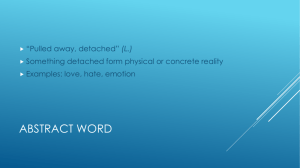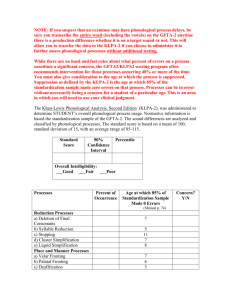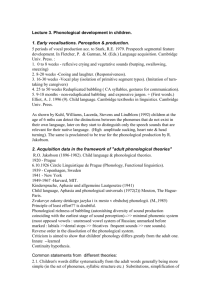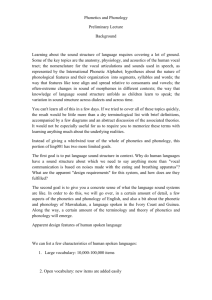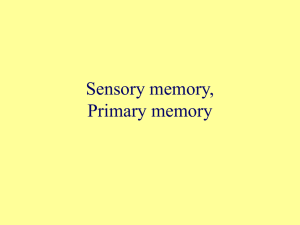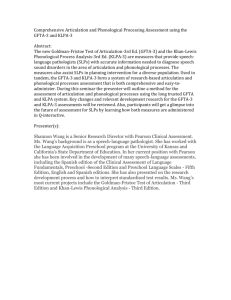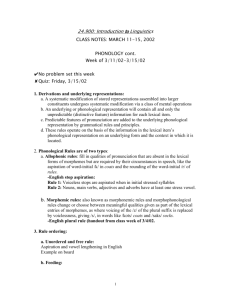li6 2007 external evidence
advertisement
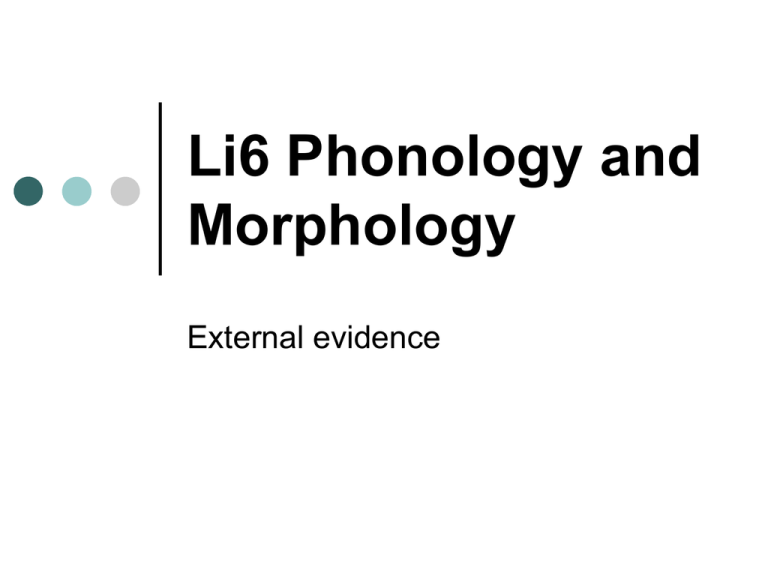
Li6 Phonology and Morphology External evidence Why external evidence? Ohala 1986: “natural experiments” he rates “ludlings as #2, only to experiments” Spawned from limited data set, thus not subject to the history/ convention critique levelled against phonological patterns in the regular language. Can reveal hidden properties of lexical items and rules not visible in native phonological system: trumped/blocked by inherited patterns • sC- clusters in English vis a vis Pierrehumbert & Nair 1995 native lexicon doesn’t provide right environments • musth, Zrelak, sixth(sed)n Acquisition Acquisition L1 r and glides study chain shifts click girl L2 spontaneous postulation of opacity DEC effect in Korean acq of Eng Acquisition of r liaison Newton and Wells 2002 Acquisition of liaison consonants by kids exposed to BrE: Homorganic j and w liaison mastered by 2;4 Both linking-r and intrusive-r appear suddenly at 3;0 “the suggestion that /r/ liaison can be described with /j/ and /w/ liaison as simply the audible results of patterned variations in timing (Gick 1999:52) is not born out by the developmental data here. If this were the case, one would expect to observe /r/ appearing at around the same time as the other types of liaison. In fact, it does not; it emerges much later.” (Newton and Wells 2002:292) Loanwords Modern Hebrew Bat-El 1994 borrowed nouns may enter phonological modification the language with no • supermarket, bank, e-mail, shopping, star all borrowed verbs are modified so as to fit into the verbal pattern • • • • • • tilfen ‘telephone’ fintez ‘fantasize’ irgen ‘organize’ kod ‘code’ kided ‘encode’ flirt ‘flirt (n)’ flirtet ‘flirt (v)’ faks ‘fax (n)’ fikses ‘fax (v)’ Evidence for root template, spreading Accidental vs systematic gaps (South) Korean word-initial r Native words: disallowed; > n Loan words: allowed English ž Native words • occurs only medially (leisure, measure…) Loan words • allowed elsewhere (Jacques, garage…) Variation Choice of adaptation is not necessarily driven by phonological markedness in the borrowing language e.g. adaptation of [θ, ð] • European French: [s, z] vs. Canadian French: [t, d] • There is also individual variation Hidden effects Could be active in native phonology, but native lexicon doesn’t present the requisite structures Japanese stress assignment wrt voiceless vowels Turkish SSP-violating clusters at word edges Convergent cross-linguistic solutions to phonotactic violations in borrowing situations, despite lack of evidence in recipient language (Steriade) • Epenthesis in initial consonant clusters • Egyptian Arabic TR (bilastik ‘plastic’) vs. sT (istadi ‘study’) Relevant structures exist natively, don’t show the effect Japanese stress assignment Turkish voicing Korean /s/ wrt [t] (to be discussed in a minute) Derived Environment effects, e.g. in Polish pagoda : pagut Avoidance effects • • Sixths in Japanese OCP effect with geminates (Heo & Lee 2004) 1. 2. 3. Honolluru ‘Honolulu’ solliroki ‘soliloquy’ Marayaram~Mallayaram ‘Malayalam’ Where do hidden effects come from? Language Acquisition Device/UG LAD provides limited set of hypotheses (BV) UG provides default rankings of correspondence constraints (Steriade) Statistical knowledge… Korean borrowing of Coda [t] Korean word-final [t|] /t, th, t’, č, čh, č’, s, s’/ Surface word-final postvocalic [t] in loans and nonce words invariably assigned to /s/ (Martin 1992, Kang 1998, Hayes 1998, Iverson & Lee 2004) supermarket nom. [supəmakhet|], dat. [supəmakhese] What appears to be involved in the Korean case is that speakers know that surface word-final [t]s most often come from underlying /s/ in their native lexicon, and they therefore assign all new words to the same pattern. Tip of the Tongue effects What TOT effects show Storage of redundant prosodic information Vaux 2003 Independence of syntactic and phonological information in lexical access Miozzo and Caramazza 1997 The availability of gender in TOT states suggests the independence of syntactic from phonological information in lexical access. Speech errors What speech errors reveal Evidence for phonological elements (features, phonemes, prosodic elements (Rime, syllable…), rules…) The “syllable position effect” “sound errors occur at a level of representation that is phonological rather than phonetic. When sounds are misordered, they acquire the allophonic characteristics suitable for their new environments (Fromkin 1971, Wells 1951 ). For example, the /k/ in Katz is phonetically a front /k/, yet in the error Fats and Kodor for Katz and Fodor, the /k/ becomes a back /k/ accommodating to the back vowel /o/ in Kodor. This suggests that the unit that is misordered is phonological rather than phonetic and, more generally, that there exists a phonological representation in production and it is at this level that these kinds of sound errors occur.” (Dell 1986) Abstract underlying representations (e.g. Fromkin 1971:34, cut the string cunt the strig) Stemberger found that more than 90% of ordering speech errors invert onset-onset, coda-coda Implicit rule learning (Dell et al. 2000—see next slide) Bifurcated grammar (LF vs. PF) Word exchange errors, such as "I left the briefcase in my cigar" (when what was intended was "I left the cigar in my briefcase"; Garrett 1980) readily cross phrase and even clause boundaries. They differ in this respect from sound exchanges, such as "he caught tourses" (when what was intended was "he taught courses"; Fromkin, 1973). Sound exchanges are most common within phrases and are strictly clause bounded (phrasal speech planning) This leads to a distinction between one level of representation that codes the proximity of elements in the surface string (PF) and one that does not (LF). Dell et al. 2000 Observation “Phonotactic Regularity Effect”: Speech errors almost always follow the phonotactics of the language being spoken. For example, in English, if [n] is mispronounced as [ŋ], the [ŋ] will always appear in a Coda (Wells 1951, Boomer & Laver 1968, Fromkin, 1971, Motley and Baars 1975). • Violations such as [ætk] ‘act’, [dlorm] ‘dorm’ constituted less than 1% of Stemberger’s 1983 phonological error corpus Curiosity Method Participants recite lists of CVC syllables in 4 sessions on different days. In the first 2 experiments, some Cs were always onsets, some were always codas, and some could be both. In a third experiment, the set of possible onsets and codas depended on vowel identity. Results Do speakers compute and apply these phonotactics online? In all 3 studies, the production errors that occurred respected the phonotactics of the experiment. Conclusions Implicit learning of the sequential constraints present in the stimuli. The language production system adapts to recent experience. Language games and toy grammars What are language games? Also called ludlings, secret languages, language disguises, play languages… not technically separate languages rather, they consist of 1-2 simple phonological rules appended to the grammar of an existing language they normally manipulate phonological elements such as phonemes and syllables Some other English games Cockney rhyming slang Ubbi Dubbi/Ob/Oppen Gloppen/Pig Greek Tubo bube ubor nubot tubo bube The Name Game Pig Elvish Ovemë heten irstfë étterlé óten héten ndëen; hentë, fïén ódingca äen ordwë fóén 3 ëttërslá róen esslë, ddaén näën "en" ndíngeth; fïen odingcá äén órdwí fóén 4 ëtterslú roën órema, ddäën äen "th" ndïngeth fién hëten óvedmï etterlá sién aen ówelvú, lsëeth ddáen äën ándomrí ówëlvë. Héntï, hangëcí lläen "k" ótén "c". Ástlylú, ddáën ándómrú ccéntsáth nóen óptën fóen hëten etterslï. Identity avoidance Name Game “But if the first two letters are ever the same, I drop them both and say the name. Like Bob, Bob drop the B like ob Or Fred, Fred drop the F go red Mary, Mary drop the M so ary That's the only rule that is contrary.” Fee fie mo Ichael (not *Michael) w-, y-, and h-dialects of Pig Latin W: way vs. a Y: you vs. ooh/eww H: who vs. ooh/eww Complex Onsets: dialect variation with truck 90 77.7 80 70 60 50 40 30 19.4 20 10 2.1 0 uck-tr-ay ruck-t-ay uck-tray (transpose entire onset) ruck-tay (transpose initial C) ruck-tray (transpose entire onset, retain 2nd C) No productions of *tuck-ray, *tuck-tray! ruck-tr-ay (n = 449) (n = 112) (n = 12) VCV-initial words: dialect variation with oven 40 36 35 30 25 20 15.6 14 15 9.3 10 8.1 7.6 6.2 1.9 5 1 0.7 0.2 0.2 0.2 oven-ov- w-oven- ay w-ay 0 oven-ay ven-o-ay oven-way oven-hay oven-yay en-ov-ay NULL ven-ov-ay oven-v-ay h-oven-h- y-ovenay oven-ay (add -ay) ven-o-ay (initial transposition) oven-way (add w) oven-hay (add h) oven-yay(add y) en-ov-ay (initial transposition) no output (n = 208) ven-ov-ay oven-v-ay (n = 90) (n = 82) (n = 54) h-oven-h-ay y-oven-y-ay ven-ay (n = 47) (n = 44) oven-n-ay (n = 36) w-oven-w-ay oven-ov-ay yay (copy max + del.) (1st consonant copying) (add h, overapplication!) (add y, overapplication!) (delete first V) (add n) (add w, overapplication!) (copy max ) (n = 11) (n = 6) (n = 4) (n = 2) (n = 2) (n = 2) (n = 1) (n = 1) Tuvan overwriting reduplication Common assumption among phonologists: Non-alternating structure is stored as such in underlying forms. Alternating structure is not stored in URs. Alternation Condition (Kiparsky ‘68), Lexicon Optimization (P&S ‘93) Kaun and Harrison 2000: Observation: Tuvan VH: all vowels in a root agree wrt [back] Question: does vowel harmony apply to non-alternating forms? Method: teach subjects Jocular Reduplication; see if new V triggers root harmony • Replace first vowel of root with [a] nom ‘book’ nom-nam • If root vowel is [a], replace it with [u] at ‘name’ at-ut Results: harmonic forms reharmonize, disharmonic forms don’t • Harmonic words idik ‘boot’ idik-adık (not *adik) • Disharmonic words mašina ‘car’ mašina-mušina (*mušı/una) Tuvan overwriting reduplication Conclusions: Disharmonic forms are fully specified underlyingly Harmonic forms are not (“Free Ride”, McCarthy 2004) Theoretical implication: Generalisations can be formed over non-alternating phonological material idik | [-bk] m a š i n a | | | [+b] [-b] [+b] Conclusions External evidence is not only useful in elucidating the structure of phonological representations and processes, but in fact appears to be vital EE bears on important questions such as: whether phonological generalisations exist in the mind of the individual that are not revealed via internal evidence productivity of processes and constraints contents of representations nature of learning processes References Bat-El, Outi. 1994. Stem modification and cluster transfer in Modern Hebrew. Natural Language and Linguistic Theory 12:571-596. Dell, Gary. 1986. A spreading-activation theory of retrieval in sentence production. Psychological Review 93.3:283-321. Dell, Gary, K. Reed, D. Adams, and A. Meyer. 2000. Speech errors, phonotactic constraints, and implicit learning: A study of the role of experience in language production. Journal of Experimental Psychology: Learning, Memory and Cognition 26:1355-1367. Gick, Bryan. 1999. A gesture based account of intrusive consonants in English. Phonology 16:29-54. Heo, Young-Hyon, and Ahrong Lee. 2004. The phonological adaptation of foreign liquids in Korean. LSO Working Papers in Linguistics 4: 47–52. Linguistic Student Organization, University of Wisconsin–Madison. P&S ‘93 Kaun, Abigail and David Harrison. 2000. Pattern-responsive lexicon optimization. Proceedings of NELS 30, A. Coetzee, Ji-Yung Kim, Masako Hirotani, and Nigel Hall, eds. Amherst, MA: UMass Graduate Linguistic Students’ Association. Kiparsky, Paul. 1968. Linguistic universals and linguistic change. In Bach, Emmon & Harm, Robert, eds., Universals in linguistic theory. New York: Holt, Rinehart & Winston. 170–202. Martin 1992 Kang 1998 Hayes 1998 Iverson & Lee 2004 McCarthy, John. 2004. Taking a Free Ride in Morphophonemic Learning. ROA 722-0305. Miozzo, Michele and Alfonso Caramazza. 1997. Retrieval of Lexical-Syntactic Features in Tip-of-the-Tongue States. Journal of Experimental Psychology: Learning, Memory, and Cognition 23.6:1410-1423. Newton, Caroline and Bill Wells. 2002. Between-word junctures in early multi-word speech. Journal of Child Language 29:275-299. Ohala, John. 1986. Consumer guide to evidence in phonology. Phonology 3:3-26. Pierrehumbert, Janet and R. Nair. 1995. Word games and syllable structure. Language and Speech 38.1:77-114. Wells 1951 Boomer & Laver 1968 Fromkin 1971 Motley and Baars 1975 Stemberger, Joseph. 1983. Speech Errors and Theoretical Phonology: A Review. Bloomington: Indiana University Linguistics Club. Vaux, Bert. 2003. Syllabification in Armenian, Universal Grammar, and the Lexicon. Linguistic Inquiry 34.1:91-125.

